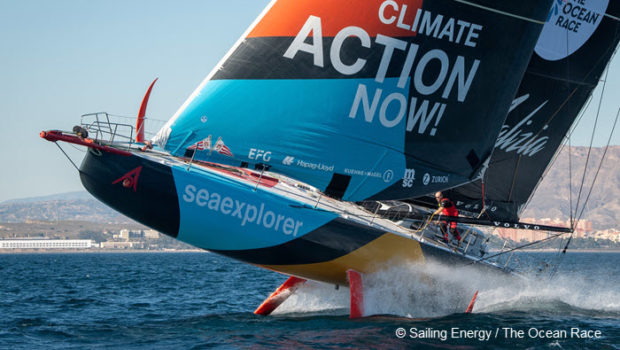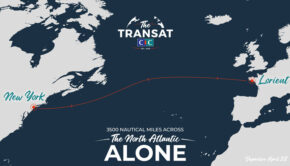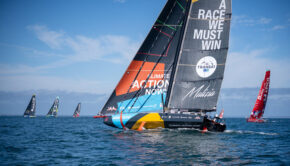Winning factor for The Ocean Race 2023
Published on January 11th, 2023
Ahead of the start of the first offshore leg of The Ocean Race 2023 on January 15, the dockside at Alicante is busy with IMOCA technical teams making last minute adjustments and improvements to what are highly complex machines.
This race could well be decided as much by the sailing teams as by their shoreside counterparts, in a class where it normally takes up to a year of sailing, testing, and refining to bring a new IMOCA up to speed and to be race-hardened or race-ready.
This aspect of this grueling 30,000-nautical mile round-the-world marathon is particularly important given the stage in that life cycle of each of the five boats taking part.
Boat, Design, Launch date
Guyot Environnement – Team Europe (VPLP Verdier), September 1, 2015
11th Hour Racing Team (Guillaume Verdier), August 24, 2021
Holcim-PRB (Guillaume Verdier), May 8, 2022
Team Malizia (VPLP), July 19, 2022
Biotherm (Guillaume Verdier), August 31 2022
Two boats – Guyot Environnement-Team Europe (formerly Hugo Boss) and 11th Hour Racing Team-Mãlama – are well down the optimization and improvement curve, with plenty of miles at sea under their keels.
But there are three others that are coming to the race still only six or seven months after first launch, for whom there are still a lot of improvements and tweaks and changes to be made.
The shore and technical teams behind Paul Meilhat’s Biotherm, Kevin Escoffier’s Holcim-PRB, and Boris Herrmann’s Team Malizia can expect to be busy throughout this six-month contest, trying to keep pace with breakages or responding to requests for improvements from their sailors to keep their race on track.
Talk to the tech guys in the Class, and it soon becomes clear why these super-complex boats take so long to mature as racing machines and how important this element could be in deciding the outcome of the race.
Jesse Naimark-Rowse is the US-born but Britain-based technical manager for Team Malizia. He has been helping to get that team’s new VPLP-designed IMOCA up to pace ever since she was launched in July last year.
“This generation of IMOCAs has become quite complicated for a boat that goes offshore,” says Naimark-Rowse. “They are completely custom-built and, because it is a development class, the rule changes with every cycle and there are always new things – different iterations of the rule that you need to try and optimize to.
“That means that every time you build a boat, it is not like the one you built before. You try to bring over as many reliable concepts as you can, but if you want a new boat that is competitive, you have to try new things.”
He makes the point that most brand new IMOCAs these days perform quite well ‘out of the box’ on flat water in early trials. There will be small things here and there to change, but the boat can be expected to work quite well.
The big difference is when you take that platform offshore and start pushing the hull, foils and rig at high speed, when the structure is subject to violent slamming and crashdowns. Then any weaknesses quickly become all-too apparent.
“You have to remember that, offshore in the breeze, these boats take an absolute beating,” adds Naimark-Rowse. “I honestly can’t describe what it is like in this generation of foiling IMOCAs when you are offshore. One of the sailors said it best – he said the boat just feels like it is going to explode all the time, as soon as you are going over 20 knots, which is like 60-70% of the time.”
The key areas of vulnerability are the hull structure, the foils, the rudders, and the mast, all of which can experience failures or require improvement for greater reliability or speed.
Jack Bouttell, the British-Australian crew member on 11th Hour Racing Team, says the hull structure is the biggest single area of concern in a new boat in a generation of IMOCAs with more powerful foils than ever before. The foils and the violent motion when underway place huge loads on the hull and retro-fitting extra strength into the structure has been the inevitable response.
“With bigger foils coming along, there are still a lot of unknowns in terms of the loads you see on the boat,” says Bouttell. “Most of these IMOCAs are now monolithic carbon hulls with fore and aft stringers all over the place, maybe a foot apart longitudinally.
“Basically, they pop off, if there is not enough stiffness in the hull. It’s the loads around the foils and the slamming. Because the boat is semi-foiling and there is no T-rudder – no foiling surface on the rudder – the boat is only half flying, which means you get quite a lot of crashdowns.”
On 11th Hour Racing Team, the US-based team has had to deal with structural issues in the hull and continuous work on electrics, but there have been myriad other improvements made in all areas of the boat. Bouttell talks about ‘sail-ability’ – making the boat as easy to sail and as rugged as possible – and ‘live-ability’ – changes that make the platform more comfortable to live on.
“Live-ability-wise, we have put a tap on the kettle, so you don’t have to pick it up and burn yourself, because it is nearly impossible to pour boiling water safely when underway,” explains Bouttell.
“And we are onto version six of our bunk design to help us sleep properly. In the cockpit we are continually modifying little bits, for example how we sit and where we control the auto-pilot from, with the right back support and comfort.”
On Team Malizia, the recent foil replacement after the Route du Rhum has been the headline item, but Naimark-Rowse says all sorts of other work has been underway on a yacht that he says is now probably at around 80% of its full race-ready state.
Among the key projects have been improvements to the steering system and rudder bearings, and continuous work on the mechanical systems on board, improving the way the various different charging systems – the engine, hydro-generator and solar – dovetail to provide the energy the boat needs.
“Here in Alicante, we feel like we are constantly improving the boat and we are planning out what we want to do in Cape Town and Itajai, and how much resource we send out to each of the stopovers, with the intention of improving the boat as we go. That’s our goal,” summarizes Naimark-Rowse.
But he adds that just about anything could happen to any of these IMOCAs when they are being pushed hard by a full crew in big seas and more than 30 knots of wind offshore.
“For any of these five teams, anything could happen on a leg where you end up in a complete firefight, literally trying to get the boat back on the startline for the next leg,” he said. “That is possible for anybody.”
Bouttell says confidence is high in the 11th Hour Racing Team in a boat that they have had plenty of time to test and to which they have made many alterations to improve its reliability. But he says he and his fellow teammates are still not completely certain where the limits of their super-powerful and stoutly-built Guillaume Verdier design are, and they are going to find out more about that once the race starts.
“It is a very difficult boat to find the limits of where to push it are,” Bouttell explains. “I think we are getting there – we are still not there.
“But once we sail against other boats we’ll find out a lot more. If there is a boat going faster than you, and you think you are already on the limit, then you know you’ve got to make a decision on whether to push harder or deal with it.”
Race details – Route – Teams – Facebook
The Ocean Race 2022-23 Race Schedule:
Alicante, Spain – Leg 1 start: January 15, 2023
Cabo Verde – ETA: January 22; Leg 2 start: January 25
Cape Town, South Africa – ETA: February 9; Leg 3 start: February 26 or 27 (TBC)
Itajaí, Brazil – ETA: April 1; Leg 4 start: April 23
Newport, RI, USA – ETA: May 10; Leg 5 start: May 21
Aarhus, Denmark – ETA: May 30; Leg 6 start: June 8
Kiel, Germany (Fly-By) – June 9
The Hague, The Netherlands – ETA: June 11; Leg 7 start: June 15
Genova, Italy – The Grand Finale – ETA: June 25, 2023; Final In-Port Race: July 1, 2023
The Ocean Race (formerly Volvo Ocean Race and Whitbread Round the World Race) was initially to be raced in two classes of boats: the high-performance, foiling, IMOCA 60 class and the one-design VO65 class which has been used for the last two editions of the race.
However, only the IMOCAs will be racing round the world while the VO65s will race in The Ocean Race VO65 Sprint which competes in Legs 1, 6, and 7 of The Ocean Race course.
Additionally, The Ocean Race also features the In-Port Series with races at seven of the course’s stopover cities around the world which allow local fans to get up close and personal to the teams as they battle it out around a short inshore course.
Although in-port races do not count towards a team’s overall points score, they do play an important part in the overall rankings as the In-Port Race Series standings are used to break any points ties that occur during the race around the world.
The 14th edition of The Ocean Race was originally planned for 2021-22 but was postponed one year due to the pandemic, with the first leg starting on January 15, 2023.
Source: Ed Gorman, IMOCA









 We’ll keep your information safe.
We’ll keep your information safe.